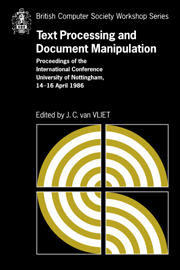 Text Processing and Document Manipulation
Text Processing and Document Manipulation Book contents
- Frontmatter
- Contents
- Preface
- The Design of Lucida®: an Integrated Family of Types for Electronic Literacy
- Tabular Typography
- A Simple Mechanism for Authorship of Dynamic Documents
- VORTEXT: VictORias TEXT reading and authoring system
- An Approach to the Design of a Page Description Language
- Intelligent Matching and Retrieval for Electronic Document Manipulation
- A Disciplined Text Environment
- Semantic Guided Editing: A Case Study On Genetic Manipulations
- Trends and Standards in Document Representation
- Textmaster – document filing and retrieval using ODA
- Combining Interactive Document Editing with Batch Document Formatting
- Formatting Structure Documents: Batch versus Interactive?
- Advanced Catalogue Production at Unipart
- Legibility of Digital Type-fonts and Comprehension in Reading
- An Overview of the W Document Preparation System
- Grif: An Interactive System for Structured Document Manipulation
- Procedural Page Description Languages
- A Strategy for Compressed Storage and Retrieval of Documents
- CONCEPT BROWSER: a System for Interactive Creation of Dynamic Documentation
- An Integrated, but not Exact-Representation, Editor/Formatter
- An Annotated Bibliography on Document Processing
- Systems used
A Disciplined Text Environment
Published online by Cambridge University Press: 05 May 2010
- Frontmatter
- Contents
- Preface
- The Design of Lucida®: an Integrated Family of Types for Electronic Literacy
- Tabular Typography
- A Simple Mechanism for Authorship of Dynamic Documents
- VORTEXT: VictORias TEXT reading and authoring system
- An Approach to the Design of a Page Description Language
- Intelligent Matching and Retrieval for Electronic Document Manipulation
- A Disciplined Text Environment
- Semantic Guided Editing: A Case Study On Genetic Manipulations
- Trends and Standards in Document Representation
- Textmaster – document filing and retrieval using ODA
- Combining Interactive Document Editing with Batch Document Formatting
- Formatting Structure Documents: Batch versus Interactive?
- Advanced Catalogue Production at Unipart
- Legibility of Digital Type-fonts and Comprehension in Reading
- An Overview of the W Document Preparation System
- Grif: An Interactive System for Structured Document Manipulation
- Procedural Page Description Languages
- A Strategy for Compressed Storage and Retrieval of Documents
- CONCEPT BROWSER: a System for Interactive Creation of Dynamic Documentation
- An Integrated, but not Exact-Representation, Editor/Formatter
- An Annotated Bibliography on Document Processing
- Systems used
Summary
ABSTRACT
Computer text processing is still in the assembly-language era, to use an analogy to program development. The low-level tools available have sufficient power, but control is lacking. The result is that documents produced with computer assistance are often of lower quality than those produced by hand: they look beautiful, but the content and organization suffer. Two promising ideas for correcting this situation are explored: (1) adapting methods of modern, high-level program development (stepwise refinement and iterative enhancement) to document preparation; (2) using a writing environment controlled by a rule-based editor, in which structure is enforced and mistakes more difficult to make.
Wonderful Appearance–Wretched Content
With the advent of relatively inexpensive laser printers, computer output is being routinely typeset. It can be expected that there will be a revolution in the way business and technical documents are created, based on the use of low-cost typesetters. Easy typesetting and graphics is an extension of word-processing capability, which is already widespread. The essential feature of word processing is its ability to quickly reproduce a changed document with mechanical perfection. However, as the appearance improves, the quality of writing seems to fall in proportion. These forces are probably at work: (1) More people can (attempt to) write using better technology, and because writing is hard, novices often produce poor work. (2) With improved technology, projects are attempted that were previously avoided; now they are done, badly. These factors are familiar from programming, and suggest an analogy between creating a document and developing a program. The current word-processing situation corresponds to the undisciplined use of programming languages that preceded so-called “modern programming practices.”
- Type
- Chapter
- Information
- Text Processing and Document ManipulationProceedings of the International Conference, University of Nottingham, 14-16 April 1986, pp. 78 - 89Publisher: Cambridge University PressPrint publication year: 1986
- 1
- Cited by


